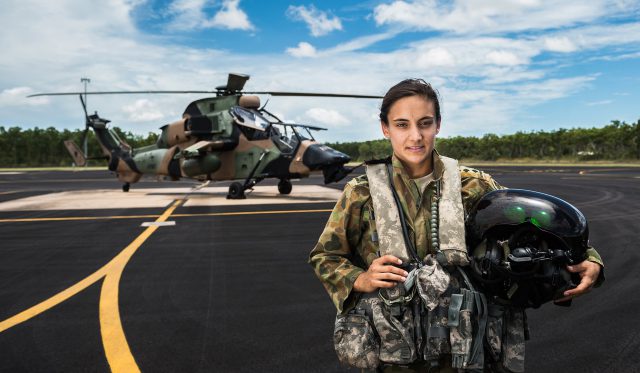
This is the second year that ASPI has run a series on The Strategist examining Australia’s approach to women, peace and security (WPS) to coincide with International Women’s Day. It’s an important topic that’s frequently overlooked at the expense of what are often deemed ‘more pressing’ security issues by the media and security commentators.
But yet again, this year’s series in and of itself showed why issues related to women’s participation, leadership and perspectives are integral to Australia’s national security. Importantly, the series includes an overwhelming number of female authors, who are usually underrepresented in security debates. It’s essential that those perspectives are considered if Australia’s approach to international security issues is to be most effective.
In 2019, the Australian government is expected to issue Australia’s second National Action Plan (NAP) on WPS. ASPI’s new Strategic Insights paper—Women, peace and security—Addressing the gaps and strengthening implementation—features the articles published in The Strategist series. The articles attempt to capture some of the debate regarding what progress has emerged from Australia’s current NAP, the gaps that have been identified and the areas where implementation needs to be strengthened. The paper examines four themes that emerged from the series:
- Defence’s approach to WPS
- The role of parliament and civil society
- Lessons from abroad
- Evolving approaches to WPS.
There has been notable progress over the last six years to ensure that Australia’s approach to international security issues and operations has evolved to include the integration of gender perspectives and to increase the participation of women in defence and security institutions.
Australian Minister for Defence Marise Payne underlines how crucial it has been and will be for Australia’s military to include gender perspectives in its own activities, and especially in missions abroad. She identifies examples of Australia’s actions in Afghanistan and Iraq to demonstrate how the Australian Defence Force (ADF) has been at the forefront of supporting women’s participation in defence institutions. Deanne Gibbon draws on her operational experience to reflect on the considerable strides that Australia has made on WPS to become a go-to nation when it comes to WPS expertise, having recently established the ADF’s operational gender adviser course.
Despite these gains and successes, however, there’s still a lot of important work that needs to be done to strengthen Australia’s implementation of WPS. In a bipartisan piece, Gai Brodtmann and Linda Reynolds advocate for stronger parliamentarian action on advancing gender perspectives and making the WPS agenda ‘business as usual’. They press for the next NAP to focus more on results rather than actions.
Similarly, Anu Mundkur and Laura Shepherd examine some of the gaps that currently exist in civil society’s engagement as part of WPS governance, particularly as it relates to ensuring that their voices are considered as part of the accountability mechanisms for the next NAP.
There are several lessons that Australia can learn from like-minded countries overseas regarding its approach to WPS and its formulation of the next NAP. Jacqui True examines the approach of international trendsetters such as Sweden and Canada that have feminist foreign policies. She identifies several areas where the Australian government could follow suit. And Jacqueline Westermann identifies how the Australian government should learn from best practices and experiences in other countries when reviewing and formulating the new NAP, drawing on the approach and experiences of Germany to advance the WPS agenda at home and abroad.
Yet the WPS agenda is not a static concept. It continues to evolve. In this context, Matthew Nash makes the case for ensuring that female ADF veterans’ voices are considered in discussions on women’s perspectives of security. He notes that efforts to increase women’s participation in the defence forces consequently entails a responsibility to ensure that their unique needs are addressed when they transition out of the defence forces.
Katrina Lee-Koo shows how non-conflict–affected countries such as Australia often forget to align their WPS policies to their refugee and asylum policies. She notes that displacement and its consequences for the domestic environment are often overlooked themes in those countries’ NAPs. Consequently, Katrina notes that the Department for Home Affairs needs to play a role in drawing up and implementing the next NAP to ensure that it represents whole-of-government policy.
Susan Hutchinson and Chris Crewther argue that a nation’s approach to WPS needs to consider policies on human trafficking, war crimes and modern slavery. Conversely, national approaches to those three issues need to consider the WPS agenda as well. And Sofia Patel encourages proponents of the WPS agenda to overcome a deeply rooted distrust of policies focusing on preventing and countering violent extremism in order to integrate those agendas.
Looking towards the future, Lisa Sharland concludes this year’s series by pressing for a long-overdue acknowledgement of WPS as an essential factor in national and international security debates, identifying four key challenges that need to be addressed if Australia ‘is to ensure that it continues to gain ground on WPS’.
ASPI would like to acknowledge and thank those contributors involved in this year’s series, and we look forward to receiving submissions from more female contributors to The Strategist on this topic and other international security issues.

